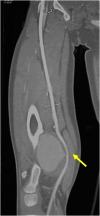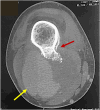Popliteal artery pseudoaneurysms in patients affected by osteochondroma
- PMID: 35420537
- PMCID: PMC11129515
- DOI: 10.1177/17085381221081626
Popliteal artery pseudoaneurysms in patients affected by osteochondroma
Abstract
Although exostosis or osteochondroma is a common bone tumor, associated vascular complications are rare. Clinical and radiological diagnoses are sometimes challenging, and there is no codification for surgical management. We report two cases of popliteal arterial pseudoaneurysms due to osteochondroma of the distal femur. A review of the current literature about case series and case reports of patients affected by arterial pseudoaneurysm complicating osteochondroma was also performed.
Keywords: False arterial aneurysms; bone exostosis; osteochondroma; popliteal pseudoaneurysm.
Conflict of interest statement
Declaration of conflicting interestsThe author(s) declared no potential conflicts of interest with respect to the research, authorship, and/or publication of this article.
Figures



References
-
- Iqbal A, McLoughlin E, Patel A, et al. Osteochondroma-induced pseudoaneurysms of the extremities mimicking sarcoma: a report of seven contemporary and one historical case. Clin Radiology 2020; 75(8): 642–e13. - PubMed
-
- Perez-Burkhardt JL, Castilla JCG. Postraumatic popliteal pseudoaneurysm from femoral osteochondroma: case report and review of the literature. J Vasc Surg 2003; 37(3): 669–671. - PubMed
-
- Nasr B, Albert B, David CH, et al. Exostoses and vascular complications in the lower limbs: two case reports and review of the literature. Ann Vascular Surgery 2015; 29: 1315–e14. - PubMed
-
- Rangdal SS, Behera P, Bachhal V, et al. Pseudoaneurysm of the popliteal artery in a child with multiple hereditary exostosis. J Pediatr Orthopaedics B 2013; 22(4): 353–356. - PubMed

